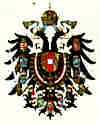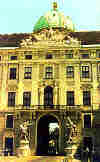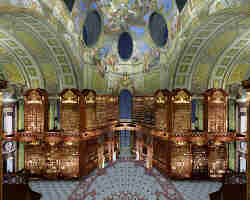
| |||||
 Opulent neo-Gothic and neo-Baroque buildings line the boulevard ringing downtown - the "Ringstrasse", a former city wall - while the imposing
spire of Gothic St. Stephen's Cathedral towers over the central city.
Three stunning palaces
grace various sections of the city; the Vienna Woods, inspiration for Strauss' waltzes,
cradle the northwest edge. Vienna's historical roots run deep, as deep as the Danube River.
Opulent neo-Gothic and neo-Baroque buildings line the boulevard ringing downtown - the "Ringstrasse", a former city wall - while the imposing
spire of Gothic St. Stephen's Cathedral towers over the central city.
Three stunning palaces
grace various sections of the city; the Vienna Woods, inspiration for Strauss' waltzes,
cradle the northwest edge. Vienna's historical roots run deep, as deep as the Danube River. | |||||
|
First settled by Celts around 800 BC, then conquered by the Romans, the country fell under a succession of rulers. In Roman times Vienna (Vindobona) was a military  camp and the Danube was the border to "Germania". In 996 the first deed containing the name Austria (Ostarrichi); was recorded, and this year the country celebrates its 1000th anniversary.
camp and the Danube was the border to "Germania". In 996 the first deed containing the name Austria (Ostarrichi); was recorded, and this year the country celebrates its 1000th anniversary.
And as the Habsburg ruled also in Spain, which largely expanded to South America, the Habsburg could say:
| |||||
 Shortly before the Habsburg era crumbled with the country's defeat
in World War I, the Austro-Hungarian Empire stretched north into what are now
Poland and the Czech Republic, east to the Ukraine and Romania, and south to
Bosnia, Croatia and Italy.
But the vestiges of that great empire still can be seen today
- in the buildings that decorate the strreet corners and in the people who populate the town.
Shortly before the Habsburg era crumbled with the country's defeat
in World War I, the Austro-Hungarian Empire stretched north into what are now
Poland and the Czech Republic, east to the Ukraine and Romania, and south to
Bosnia, Croatia and Italy.
But the vestiges of that great empire still can be seen today
- in the buildings that decorate the strreet corners and in the people who populate the town.
| |||||
 The royal apartments most reflect the influence of Empress Elisabeth "Sisi", who ruled over the empire with her husband, Francis Joseph, until her assassination in 1898 by an Italian anarchist. Sisi, a Bavarian (German) princess, couldn't abide strict court etiquette, and caused quite a stir by insisting on outfitting her apartments with gymnastics equipment.
The royal apartments most reflect the influence of Empress Elisabeth "Sisi", who ruled over the empire with her husband, Francis Joseph, until her assassination in 1898 by an Italian anarchist. Sisi, a Bavarian (German) princess, couldn't abide strict court etiquette, and caused quite a stir by insisting on outfitting her apartments with gymnastics equipment.
Emperors and their entourage, just like everybody else, needed appropriate living quarters. Since they had enough ready money at their disposal and the most famous architects at their command, it is not surprising that one stumbles upon architectural masterpieces wherever one turns in Vienna.
|

back to Culture & History


Created 1994 by © LabelArt WebDesign - Austria




 The main Habsburg palace, Hofburg, remains one of the most important buildings
in the inner city (downtown). Its earliest sections were constructed in the 1200s, and
successive rulers added their own touches. Over the years the Hofburg ("royal castle")
developed into a sprawling complex of more than 2600 rooms.
The main Habsburg palace, Hofburg, remains one of the most important buildings
in the inner city (downtown). Its earliest sections were constructed in the 1200s, and
successive rulers added their own touches. Over the years the Hofburg ("royal castle")
developed into a sprawling complex of more than 2600 rooms.




